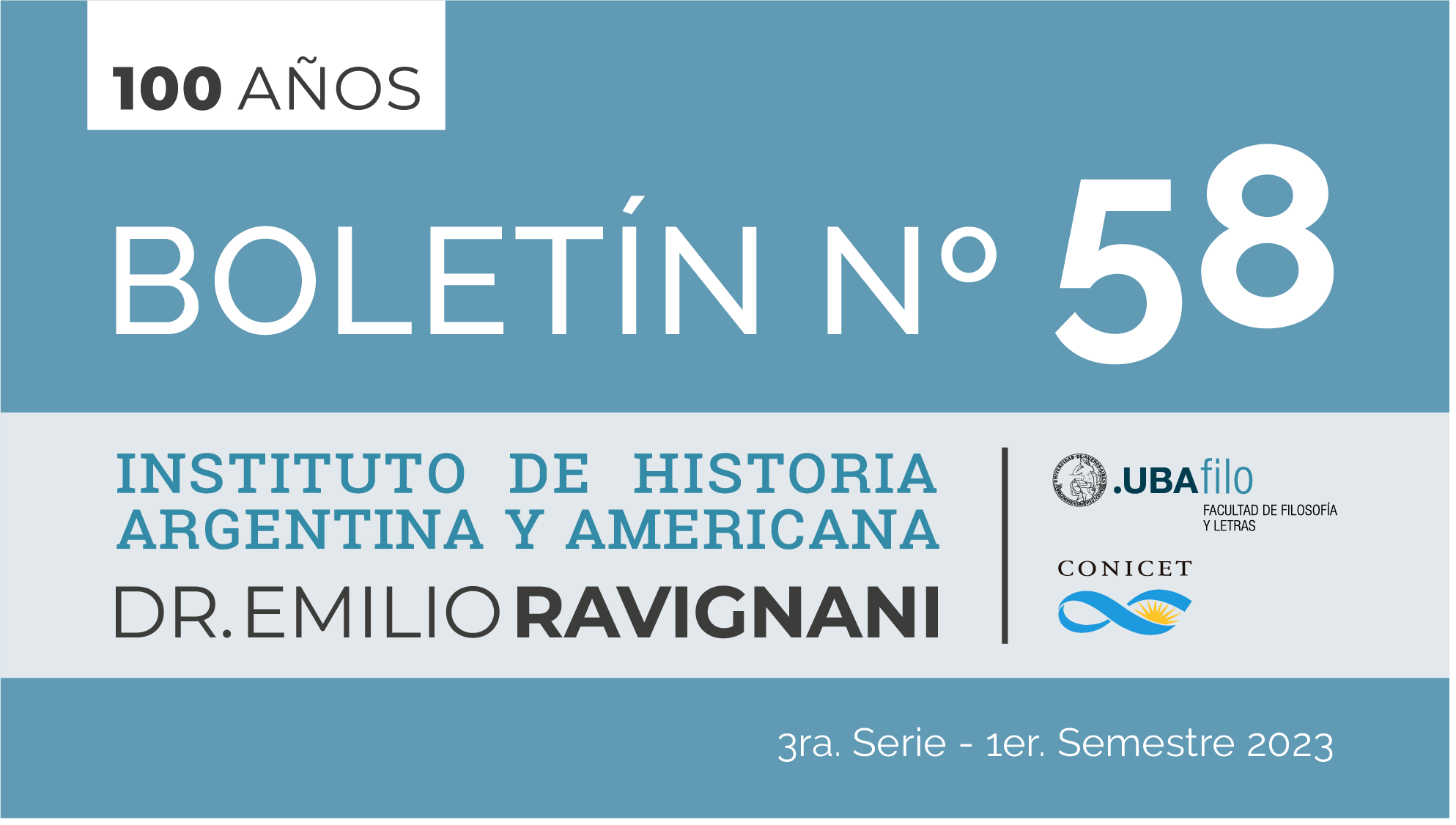Was Argentina Really Rich? An Approach To The Debate From Human Capital
Abstract
The term ‘wealth’ can be interpreted in different ways. Here we discuss one in a particular historical moment: Argentine human capital between the end of the 19th century and the beginning of the 20th century. This essay attempts to synthesize the results of two recently published works that address the issue on Argentine education levels and show that Argentina faced two major problems: low levels of human capital in comparison to countries called “recently settled” (Canada and Australia) and a problem of regional inequality that could never been solved.Downloads
References
Álvarez, B. y Ramos Palencia, F. (2018). Human capital and earnings in eighteenth-century Castile. Explorations in Economic History, 67, pp. 105-133, https://doi.org/10.1016/j.eeh.2017.10.005.
Barro, R. J. (2001). Human Capital and Growth. The American Economic Review, 91(2), pp. 12-17.
Buggle, J. y Nafziger, S. (2021). The Slow Road from Serfdom: Labor Coercion and Long-Run Development in the Former Russian Empire. The Review of Economics and Statistics, 103(1), pp. 1-17. doi: https://doi.org/10.1162/rest_a_00857.
Bunge, A. (1940). Una nueva Argentina. Buenos Aires: Kraft.
Campante, F. y Glaeser, E. L. (2018). Yet another tale of two cities: Buenos Aires and Chicago. Latin American Economic Review, 27(2). https://doi.org/10.1007/s40503-017-0052-7
Cinnirela, F. y Hornung, E. (2016). Landownership concentration and the expansion of education. Journal of Development Economics, 121, pp. 135-152. https://doi.org/10.1016/j.jdeveco.2016.03.001.
Di Tella, R., Glaeser, E. L. y Llach, L. (2013). Exceptional Argentina, mimeo, disponible en http://piketty.pse.ens.fr/files/DiTellaetal2013.pdf.
Di Tella, G., Platt, D. C. y Pacini-Ketchabaw, V. (1985). Argentina Australia and Canada: Studies in Comparative Development 1870-1965. Springer.
Droller, F. (2018). Migration, Population Composition and Long Run Economic Development: Evidence from Settlements in the Pampas. The Economic Journal, 128(614), pp. 2321-2352.
Droller, F. y Fiszbein, M. (2019). Staple products, linkages, and development: Evidence from Argentina. National Bureau of Economic Research.
Droller, F., Llach, L. y Schiaffino, P. (2022). “A Curse of the Cow? Ranching and Land Concentration in Buenos Aires During the First Globalization”. Working Paper.
Duncan, T. y Fogarty, J. (1984). Australia and Argentina: on Parallel Paths. Melbourne University.
Easterly, W. y Levine, R. (2016). The European origins of economic development. Journal of Economic Growth, 21(3), pp. 225-257.
Fogarty, J., Gallo, E. y Dieguez, H. L. (1979). Argentina y Australia (Vol. 201). Buenos Aires: Instituto Torcuato Di Tella.
Galor, O., Moav O. y Vollrath, D. (2009). Inequality in land ownership, the emergence of human capital promoting institutions and the great divergence. Review of Economic Studies, 76(1), pp. 143-179.
Gerchunoff, P. y Fajgelbaum, P. (2006). ¿Por qué Argentina no fue Australia? Una hipótesis sobre un cambio de rumbo. Buenos Aires: Siglo XXI.
Glaeser, E. L. (2004). Do Institutions Cause Growth? Journal of Economic Growth, 9(3), pp. 271-303.
Hanushek, E. y Woessmann, L. (2008). The Role of Cognitive Skills in Economic Development. Journal of Economic Literature, 46(3), pp. 607-668.
Ladeuix, J. y Schiaffino, P. (2020a). Riche comme un argentin: desigualdad educativa en la Argentina de la Belle Époque. Investigaciones de Historia Económica, disponible en https://recyt.fecyt.es/index.php/IHE/article/view/79261.
Ladeuix, J. y Schiaffino, P. (2020b). El gigante con pies de barro: ¿Fue la Argentina realmente rica? El capital humano durante la primera globalización en una perspectiva comparada. Revista De Historia Económica / Journal of Iberian and Latin American Economic History, pp. 1-35. doi:10.1017/S0212610920000208
Llach, L. (2013). Newly Rich, Not Modern Yet: Argentina Before the Depression. En L. Llach, E. Glaeser y R. Di Tella (Eds.), Exceptional Argentina (consultado 23 de junio de 2017, http://piketty.pse.ens.fr/files/DiTellaetal2013.pdf).
Míguez, E. (2005). El fracaso argentino. Interpretando la evolución económica en el corto siglo XX. Desarrollo Económico, 44(17), pp. 483-514.
Nurkse, R. (1961). Equilibrum and Growth in the World Economy; Economic Essays. Cambridge: Harvard University Press.
Pérez-Artés, M. y Baten, J. (2021). Land inequality and numeracy in Spain during the seventeenth and eighteenth century. Historia Agraria, 83, pp. 7-39. https://www.historiaagraria.com/FILE/articulos/RHA83-perez_artes-baten.pdf
Sánchez-Alonso, B. (2007). La racionalidad de las políticas migratorias en la primera globalización: el caso argentino. Revista de Instituciones, Ideas y Mercados, 46, pp. 233-264.
Santilli, D. (2019). Dos siglos de desigualdad. ¿Qué sabemos? Un parcial estado del arte en el siglo XIX desde la historia. Quinto Sol, 23(2). doi: https://doi.org/10.19137/qs.v23i2.2704
Solberg, C. E. (1987). The Prairies and the Pampas: Agrarian Policy in Canada and Argentina, 1880-1930. Stanford University Press.
Tedesco, J. C. (1970). Educación y sociedad en la Argentina (1880-1900). Buenos Aires: Ediciones Pannedille.
Copyright (c) 2022 Boletín del Instituto de Historia Argentina y Americana Dr. Emilio Ravignani

This work is licensed under a Creative Commons Attribution-NonCommercial 4.0 International License.
The copyright is transferred to the Boletín, but the authors may retrieve them and reproduce their work in other media or formats by means of a written request to the Editorial Committee. In such cases, the Boletín will be cited as the first publication of the work.
The works are licensed under a Creative Commons Attribution-NonCommercial 4.0 International License, which allows others to share the work with an acknowledgment of their authorship and initial publication in this journal.
Also, by written request to the Editorial Committee of the Boletín, the authors may separately establish additional agreements for the non-exclusive distribution of the version of the work published in this journal (for example, placing it in an institutional repository or publishing it in a book), with an acknowledgement of its initial publication here. No commercial uses are allowed.



















